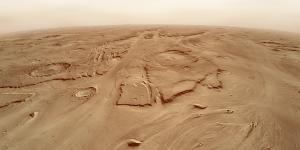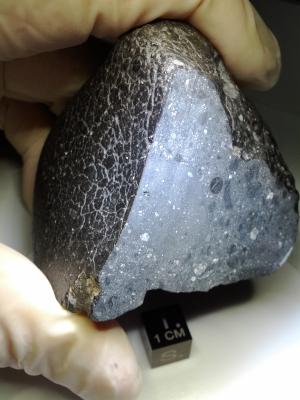Blog
A Warm Bath
23 November 2024
 NASA/JPL/Arizona State University, R. Luk
NASA/JPL/Arizona State University, R. LukEarth and Mars were very similar in their youth. Four billion years ago, both planets had vast, warm seas. But while Earth retained its oceans, the waters of Mars evaporated away or froze beneath its dusty surface. Exactly why these two worlds took such divergent paths is unclear, though it may lie in the origins of their water.
Based on geological studies, we know that Earth’s water cycle seemed to have stabilized early. From about 4.5 billion years ago to today, water has had a stable presence on Earth. For Mars, things are less clear. Clay minerals cover about 45% of the Martian surface and date to what is known as the Noachian period, which ranges from 4.1 to 3.7 billion years ago. We also see evidence of water flows from 3.7 to 3.0 billion years ago, in what’s known as the Hesperian period. During the Amazonian period, which dates from 3 billion years ago to today, Mars seems to have been mostly dry. We have little evidence of the earliest period of Mars, known as the pre-Noachian. But a new study1 peels back the Martian ages to give us a glimpse of the first epoch of Mars, and it comes from a Martian meteorite known as Black Beauty.
 NASA
NASAThere are about 200 meteorites known to have come from Mars, and they are currently the only physical samples of Mars we have on Earth. One of the larger meteorites, Northwest Africa 7034, was discovered in Western Sahara in 2011 and is nicknamed “Black Beauty” because of its rich black coloring. It’s made of material that’s about 4.4 billion years old and contains more water than any other Martian meteorite. But since it was only ejected from Mars 1.5 billion years ago, it is difficult to determine whether Black Beauty formed in a wet environment or if it gained water during the Noachian or Hesperian period.
This new study doesn’t focus on Black Beauty as a whole, but rather on small crystals of zircon embedded within it. These crystals can be dated to 4.48–4.43 billion years, meaning they formed in the Pre-Noachian period. What’s interesting is that the crystals have layers of iron, aluminum, and sodium in a pattern known as oscillatory zoning. Since zircon is igneous in origin, this kind of banding is almost unheard of in zircon crystals. On Earth, there is only one place where such a pattern occurs, which is in hydrothermal geysers such as those found in Yellowstone National Park.
The presence of these crystals in Black Beauty proves not only that Mars was wet during the Pre-Noachian period, but that it was geologically active with warm thermal vents. Similar vents on Earth may have triggered the formation of life on our world. Whether life ever existed on Mars is still an unanswered question, but it is clear that the conditions for life on Mars did exist in its earliest history.
Gillespie, Jack, et al. “Zircon trace element evidence for early hydrothermal activity on Mars.” Science Advances 110.47 (2024) ↩︎